YUMA PROVING GROUND, Ariz. – More than two dozen people, soldiers and military contractors, fill the ‘mission command’ room here on a Friday morning. The terrace style seating ensured everyone had a view of the five large screen TVs stitched together at the front.
Each screen showed a different view of the event in real time. An improved Paladin, self-propelled howitzer, this one is known as ‘Prototype Zero,’ because it is the first to employ all the improvements needed to more than double the range of the cannon, was about to launch a guided 155 mm projectile over 65 km in about four minutes to strike an tan sport utility vehicle alone on the Arizona desert.
High-speed cameras with the weapon capture the firing after countdown and follow the round into the air as it spins toward its target. Another digital display uses a series of radars to track the flight path while the round hurtles beyond 50,000 feet altitude.
Another 166 cars are backed up on highway 95, which had also been closed down as it skirts the test range area. Though this round is guided, and its path only parallels the highway, a misguided shot could do serious damage should it stray off course and strike a passing minivan.
On screen, the Paladin cannon roared, the muzzle flashed and the spinning 155mm projectile launched on its path.
Cameras caught it mid-flight as radars began to track its flight overhead as the tan-colored Chevrolet suburban sat on the other end of that flight path. Minutes later, a voice began a 10-second countdown to impact.
As the round landed within 1 meter of the Suburban, the room erupted in cheers, the culmination of more than 18 months of planning, tooling and tinkering bringing dreams of the Extended Range Cannon Artillery program another step closer to reality.
Or, as the Vice Chief of Staff of the Army Gen. Joseph Martin said, “We’re making artillery great again.”
Shortly after launching the first round, the crew loaded and launched the XM1113 Rocket Assisted Projectile the same 65km distance, officials said.
The ERCA program is one of a handful of Long Range Precision Fires pieces that the Army expects to use to outgun, outrange and outmatch Russia and China and anyone else on a future battlefield. They’re also building a strategic cannon that could reach out to 1,000 km with the type of weapon that used to be carried only by ships or on rails.
RELATED

They’re improving missile firing capabilities and volume.
But for the ground-level soldier, some of the most tangible work is likely to be found in the ERCA program. That’s because it puts between 70km and perhaps as far as 100km-range targets within reach of a brigade combat team within a message or radio call away.
While the engineers, researchers and technicians figure out how to squeeze more kilometers from a round that’s been in service for a century, others are figuring out how it will change battlefield tactics.
Currently, divisions supporting brigade combat teams have to call on rocket forces, outside units or airpower to deliver firepower at more than 60km. That limits what’s available for those brigades to move around the battlefield.
“It comes down to providing them additional range capability at the division level,” Martin said.
The plan is to have a battalion of these longer range howitzers, protected, mobile and with autoloaders that more than double the firing rate at the fingertips of division commanders to support those brigades.
And that dream isn’t far from reality.
Further testing is needed but the Army expects to have 18 prototypes to field to battalions by 2023.
Later this year, another demonstration called “Project Convergence,” also at Yuma Proving Ground, will showcase a small slice of target recognition and acquisition through sensors and artificial intelligence that then sends its data to the shooter.
That’s the ultimate goal for the combined fires and networks projects, connecting all available sensors with all shooters so that the right weapon can be used to take out a target on command.
And, Martin said, the use of AI and sensor technology will shorten the feedback for commanders to seconds rather than minutes on the battlefield.
The work to harden the Paladin, add a longer cannon and make other modifications are turning the self-propelled howitzer into a movable piece of weaponry that’s also protected.
The standard towed 155mm howitzer will continue firing its conventional-range munitions for shorter-distance missions. But the ERCA Paladin adds much needed range to the fight.
Brig. Gen. John Rafferty heads the Army’s Long Range Precision Fires Cross Functional Team, which houses the ERCA program, is simultaneously developing the Precision Strike Missile and the Strategic Long Range Cannon to go even deeper with fires.
But even the ERCA program isn’t stopping at the 70km range, Rafferty said. There are opportunities to stretch the boundary to 100km, with further testing and technologies.
In the next few months, Rafferty said, the Army will likely select the unit that will receive the 18 prototype cannons in 2023. That will help them further develop and refine the platform and how it’s used.
And those additions, longer ranges, mobile platforms and higher volume of fires, mean that the fires community, from the artillery schools to the Fires Center of Excellence, need to determine how they best fit in the future battle plan.
The Army is developing doctrine for those cannoneers, who will be a bigger part of the fight than they have been even in recent artillery deployments to the Middle East. Section chiefs and cannoneers will have to learn new procedures while commanders will develop and practice new techniques for how to use the artillery.
And once the autoloader is added in, logistics and supply are crucial.
That’s because the system will be designed to fire as many as 10 rounds per minute with a magazine of 30 rounds. meaning the magazine could be empty in a matter of minutes and in need of a reload.
While the autoloader means less strain on the individual soldier feeding rounds and likely a smaller crew on the platform, the job will still be demanding.
“When we think about automation, it’s not about making life easier for soldiers,” Rafferty said. “Life’s always going to be hard for the soldiers.
It’s just going to be a different set of challenges.
But, Rafferty said, the Army doesn’t have to look too far back into its history to see where artillery formations provided what are known as “general support” fires from 8-inch cannons to rockets used in formation during the Cold War, when the United States anticipated slugging it out with Russia over long distances in Europe.
Right now, he added that all of the general support cannon artillery for the Army is in the Army National Guard. While it isn’t a bad thing to have that asset in the Guard, it might not be best to have all of it reside there, he noted.
Todd South has written about crime, courts, government and the military for multiple publications since 2004 and was named a 2014 Pulitzer finalist for a co-written project on witness intimidation. Todd is a Marine veteran of the Iraq War.
